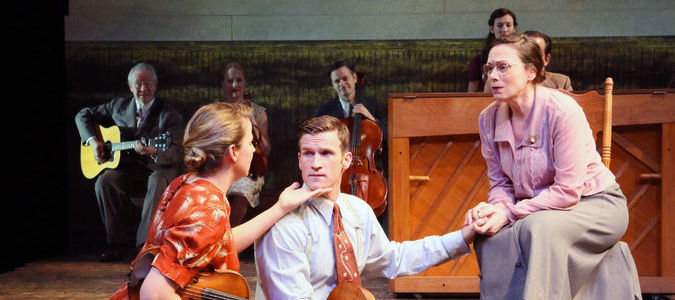

Allegro
Opening Night: November 19, 2014
Closing: December 14, 2014
Theater: Classic Stage Comp.
Follow the story of Joe Taylor, Jr. from cradle to early manhood in this loving and wise exploration of America’s coming of age, as seen through the eyes of a young physician learning about the mysteries of life and death. Discover this little-known jewel of a show, long considered Rodgers and Hammerstein’s most personal and groundbreaking work of musical theatre. This second installment of our Musical Theatre Initiative will once again be helmed by Tony Award-winning director John Doyle (Passion). Come and experience another musical masterpiece in a luminous staging by one of our greatest interpreters of the form.
BUY TICKETSREAD THE REVIEWS:
November 19, 2014
First seen on Broadway in 1947, Allegro was the third theatrical collaboration between Richard Rodgers and Oscar Hammerstein II. Allegro didn’t enjoy the runaway success of Oklahoma! or the unanimous critical acclaim of Carousel, and has since languished in relative obscurity. Die-hard fans will claim that this epic coming-of-age tale (which borrows more than a few pages from German playwright/director Bertolt Brecht) was ahead of its time, an underappreciated gem just waiting to take its position in the pantheon of great musicals. Yet in a new revival at Classic Stage Company, it’s hard to see Allegro as anything but dated. This is especially apparent under the direction of John Doyle, whose actor-as-musician stagings (like the brilliant 2005 Broadway revival of Sweeney Todd) regularly garner fresh and exciting insights from older works. (Who could forget Patti LuPone’s tuba-playing Mrs. Lovett?) Not so with Allegro, suggesting that stripped-down to its essentials, there’s just not much to draw on from Hammerstein’s shallow book. The story charts the path of Dr. Joseph Taylor Jr. (Claybourne Elder) from birth to midlife crisis. The costumes and actors never change in this bildungsroman-like story, meaning we have to endure the always-awkward stage conceit of a grown man playing a baby. With the help of a meddlesome Greek chorus, this infant in suspenders and argyle socks meets his dad (Malcolm Gets), mom (Jessica Tyler Wright), and grandma (Alma Cuervo). Joe wants to be a small-town doctor, just like dad, but his girlfriend, Jenny (Elizabeth A. Davis), has other plans. When girlfriend becomes wife, she pressures Joe to take a high-paying job in Chicago catering to rich hypochondriacs. Spiritually floundering in material success, Joe wonders how his life so radically diverged from his childhood aspirations.
READ THE REVIEWNovember 19, 2014
When the Rodgers and Hammerstein musical Allegro originally opened on Broadway in 1947 it was a certified event. Advance ticket sales for the latest work by the creators of the smash hits Oklahoma! and Carousel were in the area of $750,000, and that was at a time when the top Broadway ticket price was six dollars. Directed and choreographed by Agnes de Mille, the production featured a cast of dozens, plus more than twice as many dancers. But this audaciously experimental show received mixed reviews and closed after a mere nine months. It has rarely been seen since. The new off-Broadway Classic Stage Company production directed by John Doyle is unlikely to change the fortunes of Allegro. Performed, as was the original, on a mostly bare stage, it features but a dozen actors who — in the now familiar and tired style championed by the director of the recent Broadway revivals of Sweeney Todd and Company — play their own musical instruments. To say that the approach doesn’t do justice to the score is an understatement, although to be fair, it’s hardly one of Rodgers’ best. Nor is the libretto by Hammerstein, which seems clearly influenced by both Our Town and Brecht in its stylized account of a young doctor’s life from birth to age 35. Featuring a Greek chorus often commenting on the action, it never fully succeeds in bringing its story or characters to vibrant life. Although undeniably ambitious in its themes, its distancing effect makes it easy to understand why the musical was rejected by audiences at the time.
READ THE REVIEWNovember 19, 2014
The clustered chorus lockstep. The intense, face-forward performing style. The full cast with instruments in tow, acting as their own orchestra. You got it: a favorite old musical has been John Doyle-ized. Allegro—now playing at Classic Stage Company through Dec. 14—is the latest piece to feature director Doyle’s deconstructive, chilly approach. A 1947 Rodgers and Hammerstein flop that represented an adventurous departure in tone for the prolific duo, it seems an apt match since the composition is literally clinical—depicting 35 years in the life of a small-town, Depression-era doctor named Joseph Taylor Jr. (the appealing Claybourne Elder), who contemplates whether or not to open a swanky private practice in the big city. Doyle’s stripped-bare, outside-the-box directorial style has paid many dividends in his past dalliances with musical revivals, notably Sweeney Todd and Company, perhaps because Stephen Sondheim’s layered scores already flirt with duality for its leading men, even when one of them happens to be a murderous psychopath. (Ironically enough, Sondheim was a PA for Mr. Hammerstein on the original Allegro.) However, when applied to something so straightforward, Doyle’s vision feels more artificial because the work itself doesn’t have the same dark substructures for these concepts to latch onto. Rodgers and Hammerstein’s contemplative curio was conceived very much with its 1940s era in mind—imagine a showtune-laden Thornton Wilder play and you’d kind of be there. So the plastered smiles and deadpan line readings give off a waxworks vibe here that undercuts the sincerity of its original creators.
READ THE REVIEWNovember 19, 2014
With all the larks praying and bird-pairs bursting in song, it’s sometimes hard to hear the real voice of Oscar Hammerstein in his lyrics. But his “poetic,” not to say ornithological, flights, especially as set to Richard Rodgers’s gorgeous ballad tunes, do not represent him well. He was, first of all, an experimental playwright; indeed, his experiments in musical storytelling were so successful they quickly became the standard template for the form. If they now seem passé, think about how they must have seemed then: the attack of Oklahoma!, the surrealism of Carousel, the cross-cutting of South Pacific, the role of dance in The King and I. Think, too, about their deadly serious themes. (A major character dies in each.) Hammerstein was no lightweight; he had grown up in the theater and wanted the musical to share fully in the advances being made by the great American plays of the time. And so when he and Rodgers set out in 1947 to top Oklahoma! and Carousel, surely Our Town and The Glass Menagerie were on his mind. He proposed a contemporary story, told in an epic-theater style, with speaking choruses, minimal sets, and a love story that flatlines. Its theme: the perils of success. “It is a law of our civilization,” he later wrote, explaining himself, “that as soon as a man proves he can contribute to the well-being of the world, there be created an immediate conspiracy to destroy his usefulness, a conspiracy in which he is usually a willing collaborator.” Thus was born Allegro. It flopped. Well, actually, it lasted 315 performances and may have made a little money, but its afterlife has been exceedingly quiet. No Broadway revivals, few major productions anywhere. With its heavy dancing (Agnes de Mille directed and choreographed), large orchestra, and cast of 67, Allegro as originally conceived would seem to be un-producible today, an impression furthered by a 17-year-old production assistant who grew up to be Stephen Sondheim. Writing about it over the years as a kind of cautionary tale, he has done as much as anyone to keep the cult of Allegro alive, noting its problems but implicitly fueling the hope that someone, someday, might find a way to solve them.
READ THE REVIEWNovember 19, 2014
Having your own personal Greek chorus has never sounded all that appealing. Who wants to be surrounded by a lot of second-guessing Everypeople, the way poor Oedipus and Electra were, while having to listen to observations like: “Boy, that was a stupid move, you shortsighted fool. You’re doomed, doomed!”? But if you absolutely had to live among an echoing, oracular throng, you could do a lot worse than the personable team of singing kibitzers that has been assembled at Classic Stage Company to see one Joseph Taylor Jr. through his growing pains. They’re highly empathetic and encouraging; they trill as prettily as nightingales and they all play, quite dexterously, their own musical instruments. Such is the nature of the ensemble provided by John Doyle’s newly glowing interpretation of the lackluster 1947 musical Allegro, which opened Wednesday night. Allegro is known today, if at all, as the show with which Richard Rodgers and Oscar Hammerstein II followed up the trailblazing success of their first two collaborations, Oklahoma! and Carousel — and for the first time fell flat on their faces. It was the introduction of the chorus to the American musical — I mean, a Greek-style chorus as opposed to the usual dancing backup singers — that made Allegro seem daring when it opened. And that show’s rejection by many critics and much of the public (its 315-performance run was decent, but meager by R&H standards) was partly attributed to its experimental nature.
READ THE REVIEW






















